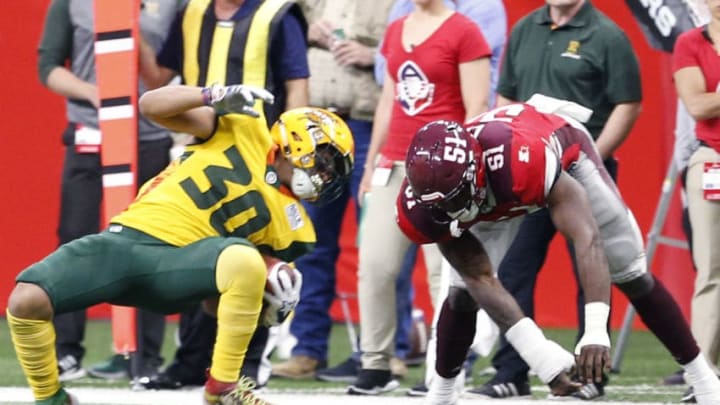Two months into their on-field launch the AAF is set to suspend football operations. Was this the last hope for an intermediate league connecting the NCAA and NFL?
After just eight weeks of regular-season operation, reports surfaced that the Alliance of American Football (AAF) is shutting down. Though not officially folding yet, it appears that it will soon make that clear.
It’s a disappointing exit for yet another professional football minor league to take after it took the stage of offseason football attention and young player development.
AAF majority owner Tom Dundon made headlines last week by hinting to USA Today that a lack of cooperation from the NFL Players’ Association (NFLPA) would soon prompt the fledgling league to fold. As of right now, the NFLPA does not allow its players to play in AAF games in the NFL’s offseason. The AAF hoped to use practice squad players in its games, which were scheduled to conclude in two more weeks.
What’s clear is that the AAF will soon represent another failed chapter for a pro football minor league to take hold in the United States.
Was this the last reasonable non-NFL alternative after college football?
An undrafted college football player can sign on to an NFL team’s practice squad (that is, if rookie minicamps and a preseason roster spot do not present opportunities). He could also explore options north of the border in the Canadian Football League (CFL) and find his way back in America, such as former NFL stars Warren Moon, Andre Rison, Doug Flutie, and Jeff Garcia.
Another option that will be available soon is the reincarnation of the XFL, which Vince McMahon (the WWE’s Chairman and CEO) is set to restart in 2020 after one notorious season in 2001.
“The new XFL is an exciting opportunity to reimagine America’s favorite sport,” McMahon said in a press release. “As we move towards kickoff, we look forward to listening and implementing innovative ideas from players, coaches, medical experts, technology executives, the media and most importantly football fans.”
The cities of Dallas, Houston, St. Louis, Los Angeles, Washington, D.C., New York City, Seattle, and Tampa will each host an XFL team, which will similarly compete in a ten-game season followed by semifinals and playoffs.
While the entertainment value promises to be flashy and the gimmicks might be enticing, will the league actually help develop players for the NFL? Will the quality of football be beneficial for players and a draw to football fans trudging through a long offseason?
The lesson learned from the AAF this spring is: probably not.
Where do we go from here?
The NFL has shown little interest in a developmental league such as the NBA’s G-League and MLB’s AAA farm team system (and extended hierarchy below, including A, AA, and rookie leagues). Even lower-tier minor leagues akin to hockey’s AHL and ECHL are not a feasible option, as the AAF has shown us.
The NFL shoulders a portion of the blame for not wanting to harm its 32-team system laden with practice squads. Even NFL Europe fizzled out more than a decade ago when it stopped becoming a viable option for young players to develop in hopes of reaching an NFL sideline.
Perhaps it really is this simple. If the NFL wanted to fund a secondary league, it could. Yet even the best-intentioned alternatives continue to fail. For now, it remains the NFL’s way or the highway.
